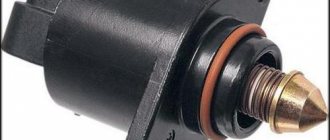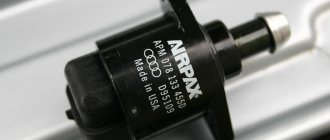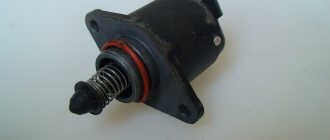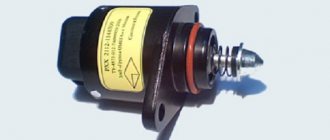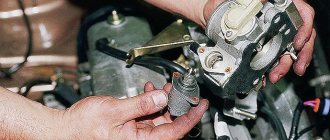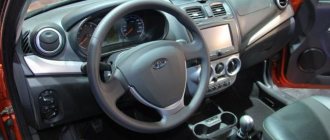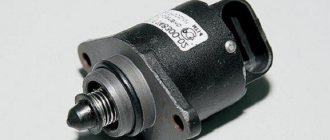If “floating” speed appears on your Lada Kalina, then you definitely need to check the idle speed sensor. Among all engine problems, incorrect idle speed can occur in the following cases:
- The engine stalls when changing gears.
- The engine speed increases or decreases independently.
- When stopping the car with the engine running, the speed drops sharply.
All of these symptoms indicate a faulty idle speed sensor. But before you start repairing it, you need to know exactly where it is and what it looks like.
Where is the idle speed sensor on the Lada Kalina and its replacement
Car : Lada Kalina. Asks : Ivan Vinokurov. The essence of the question : I want to replace the idle speed sensor, but I don’t know where it is located?
Good afternoon, I recently had this problem. When I stop at a traffic light, the idle speed starts to fluctuate, up and down! Friends say that the reason may be in the idle speed sensor, but I don’t know where it is located. Please tell me how to find it and how to solve my problem?
The idle speed sensor or, in other words, the idle speed regulator ( IAC ) is designed for stable engine operation when the gas pedal is released. It is this device that provides a minimum supply of air and fuel when the car is stationary and idling.
Causes of the phenomenon
Drop in speed and failure of the gas pedal
There are few reasons for the phenomenon of “failure” when pressing the gas pedal. It often appears after unsuccessful engine chip tuning and is accompanied by an increase in fuel consumption, but there are other problems directly with injection. So, let’s look at the main reasons for the “failure” effect:
Identifying and eliminating ECU errors
Condition of the candles. On the left the mixture is too rich, on the right it is too lean.
These are all the main reasons that can lead to gas pedal failure.
Dips during acceleration
Once the causes are considered, we can consider how to deal with the problem. So, let’s describe step by step what needs to be done when the gas pedal has dips during acceleration:
- The first step is to check the spark plugs. The appearance of carbon deposits or spark plugs that are too clean indicate that the mixture is not adjusted correctly. It is worth adjusting the correct amount of fuel mixture.
- Ignition wires can also cause the vehicle to malfunction.
- A clogged throttle can lead to failures during acceleration.
- The condition of the air filter affects the formation of the mixture, so it is worth changing it on time.
Air filter clogged
Dirty fuel filter
Dirty fuel filter
- ECU errors can also lead to accelerator failures.
- The last reason is clogged injectors. They need to carry out diagnostics, check functionality, and also clean and replace faulty elements.
Thus, the causes of failures during overclocking have been identified and can be eliminated.
Idle speed sensor Lada Kalina: functionality
The main purpose of the Lada Kalina idle speed regulator is to measure the parameters of the intake system and adjust the speed accordingly. The pulses are sent to the electronic control unit, and the volume of the fuel-air mixture is adjusted.
The principle of operation of the device comes down to the timely opening or, conversely, closing of the channel that bypasses the throttle valve. When the power unit begins to operate, the crankshaft sensor transmits speed data to the controller, the ECU, according to specified algorithms, calculates what action is necessary - opening or closing - and transmits the signal to the IAC. The conical needle (rod) blocks or opens the channel, thereby causing an increase or decrease in the supply of the fuel-air mixture.
The device allows you to control the volume of air supplied to the combustion chamber. The air flow goes through the throttle valve along the intake tract. At idle, the throttle is closed.
The IAC is involved in warming up the power unit with 8 or 16 valves, ensuring that the temperature required for stable operation is achieved. When the ignition is turned on, the rod enters a special hole - the sensor takes its original position.
Functions of the idle speed sensor on Kalina:
- allows you to determine the volume of air;
- ensures proper engine warm-up;
- determines and adjusts the number of revolutions.
Where is the IAC located - on the throttle body, slightly lower than the throttle position sensor is located. The device is inserted into the bypass channel.
Operating principle of IAC
When the engine is running without increasing speed, that is, at idle, a minimum volume of air enters the combustion chambers of the cylinders. This occurs regardless of the throttle valve being in the closed position. The volume of intake air consumed is monitored and measured by the MAF (mass air flow sensor), which sends data to the ECU.
Based on the information received, the control unit supplies the required amount of fuel to the cylinders through the injectors. At the same time, the controller monitors the crankshaft speed using its position sensor (DPKV). According to the data obtained, the IAC needle opens or closes, controlling the air supply past the throttle valve, which at this stage is not involved in the operation of the engine.
If the engine has not yet reached the set temperature, the controller uses the IAC to increase the air supply, increasing the crankshaft speed to warm up the power unit faster. Thanks to this mode, the car can start moving almost immediately, without the need to reach operating temperatures.
Technically, the IAC is not a sensor, it is an actuator, so the controller cannot diagnose its malfunction. This means that the “Check Engine” icon will not light up on the instrument panel if the regulator breaks down. In their symptoms, IAC malfunctions are similar to TPS (throttle position sensor) malfunctions. But in the case of the latter, the icon will definitely light up, indicating engine problems.
How does the idle air valve work?
Without going into details, which are not really necessary for a simple car owner, the idle air control works according to the following principle:
When the engine is idling, it receives a certain amount of air. The crankshaft sensor takes into account the number of revolutions and supplies data to the control unit, which, in turn, already issues IAC commands.
The valve increases or decreases the amount of incoming air, regardless of the throttle position. By the way, the sensor is located in its body.
As for cars with a carburetor engine, they are equipped with a slightly different idle speed control system. Manual configuration is required there. If you have certain skills, knowledge and experience, you can adjust the idle speed simply by turning special screws. If you are not sure of the correctness and accuracy of your actions, it is better to entrust this work to the specialists at the service station.
This element is not very expensive, but at the same time it is not cheap. Its price depends primarily on the manufacturer. And especially, the price tags began to differ due to the growth of the dollar exchange rate.
- KZTA 573 rub.
- Omega 639 rub.
- AvtoVAZ 695 rub.
- GM 1074 rub.
There are several other manufacturers, but there is no point in listing them, since the average price range is, in principle, understandable. If you have any questions about replacing, removing or installing the IAC on a Priora, please discuss it below in the comments.
Let's sum it up
Having completed the assembly process, we check the correct functioning of the valve-regulator on the LADA Kalina car. If the idle speed is within the specified limits, then the device is installed correctly, and no third-party air leaks are observed in the intake system.
The idle speed regulator is designed to stabilize the engine speed. A logical question arises: is the presence of this device so important and necessary? And also whether it is possible to do without it at all and how to properly carry out repairs in the event of a malfunction. The entire operation of the car depends on this device.
In order to understand what work processes are affected by the idle air regulator and why there is a need to regulate its operation, it is necessary to have an understanding of what the principles of its operation are.
What is the essence of the sensor?
The idle speed sensor is represented by a special device, which is considered a measuring device. Its main task is to interact with data. As a result of their transformation, all information is displayed on a special display.
Idle speed sensor is not an entirely correct name; it would be more appropriate to call this device a regulator. This element plays an important role in the smooth functioning of the entire vehicle mechanism.
The sensor is an actuator, the malfunction of which is not so easy to determine. This is due to the lack of self-diagnosis in Lada Kalina cars.
The device itself is responsible for the volumes of air that enter the motor. It penetrates the engine when the throttle is closed, thereby ensuring optimal idle speed.
The regulator is often used to warm up the car. Thanks to this, the mechanism reaches its optimal operating temperature. On average, this indicator varies from -40 to +30°C.
When the ignition is turned on, the rod located in the sensor extends all the way. As a result of this, it reaches a special hole, which allows the regulator to return to its original position.
So, it is necessary to note the main functions of the regulator:
- regulates the optimal amount of air;
- warms up the engine to the required temperature;
- indicates the number of engine revolutions.
The uninterrupted functioning of the element is due to the simultaneous change in volume, regardless of the number of steps.
Where is the idle speed sensor (IAC) located?
You need to look for the sensor under the hood closer to the windshield of the car on the throttle assembly.
Open the hood and let's go
- Remove the screen from the engine . Disconnect the cable connectors from the blocks on the throttle block. The regulator is located under the throttle position sensor, on the throttle body.
Actually, the sensor itself is close (or rather, the regulator, because it controls the idle speed, and does not just take readings).
You can simply quickly remove the hoses and plug the holes with suitable plugs, such as old spark plugs.
The removed regulator is usually very dirty. You can try to wash it, but this is of little use - in addition to contamination, the rod also wears out. The best solution is to install a new one.
Signs of IAC malfunction
Among the signs that directly or indirectly indicate incorrect operation of the idle speed sensor are the following:
- the engine does not start well - it becomes impossible to start the engine without pressing the gas pedal;
- when switching to neutral gear, “dips” in speed and their instability are observed;
- when changing gears, the speed drops or the engine stalls completely;
- the engine does not warm up well at low temperatures, since increased speeds (1500 rpm) are not reached;
- after turning on energy consumers (high beams, heater, air conditioner), the speed begins to “sag” or “float”;
- The engine spontaneously increases and decreases speed.
The IAC cannot be repaired; the device must be replaced. Before changing the idle air regulator, it is advisable to flush the throttle assembly.
Return to contents
How to check the regulator
There are a lot of ways to diagnose ICC. The most effective and simple methods for checking the Kalina idle speed control:
- Routine IAC testing for performance. To do this, the device must be removed from the throttle assembly and the terminal block connected if it was disconnected for dismantling. After this you need to start the engine. At the moment of startup, the needle of a working device should extend. If this is not observed, the regulator is broken.
- Checking the supply of the required voltage to the sensor. You need to disconnect the terminal block from the IAC and connect a voltmeter to the terminals. After this, one person turns on the ignition, and the second measures the resistance at all terminals of the block. If there are no faults, the voltmeter reading should be approximately 50 ohms. The voltage should be at 12 V. If it is significantly less, this indicates a battery malfunction or an electrical circuit break in one of the sections.
- Measuring the resistance of the internal and external windings of the regulator. To do this you need to use a multimeter. The measurement results should not be lower than 40 Ohms and higher than 80 Ohms. If you deviate from the specified range, the idle air control must be changed.
Device check
To clarify how efficient the device is, perform diagnostics:
- dismantle the device, connect the power terminal block and start the power unit. If the device is working properly, the rod extends, otherwise a new one should be installed;
- checking with a voltmeter is acceptable. After disconnecting the device from the contact chip, check the resistance parameters. Optimal is about 50 ohms. Voltage - 12 V. If the voltage is less, there are problems in the operation of the electrical circuit;
- checking the resistance of the internal and external windings of the device using a multimeter will also tell you whether it is working properly. The contact parameters should be in the range from 40 to 80 Ohms.
Idle speed sensors for Lada Kalina are produced by different companies, but are interchangeable and do not differ much in quality. This is an inexpensive part, and if it malfunctions, it requires immediate replacement.
XX sensor replacement guide
Replacing the idle speed sensor does not require much time or special skills.
- It is necessary to turn off the engine and allow the car to cool slightly.
- Disconnect battery.
- Remove the required regulator from the throttle assembly.
- Disconnect the plug and unscrew the two bolts. Then pull out the entire structure.
- With a new sensor, return everything to its previous position in the reverse order.
Photo gallery “Installation instructions”
Below you can find out how dismantling occurs.
Removal and installation
Replacing the brake pedal sensor on Kalina is carried out using an adjustable wrench set to “19”. The sensor itself is located above the brake pedal under the steering column. Conventionally, the removal stages can be divided into 5 steps:
- Before starting electrical work, it is recommended to disconnect the negative wire (terminal) from the battery.
- Then you need to move into the car interior on the driver’s side. For ease of operation, it is advisable to move the driver's seat in the opposite direction from the dashboard.
- Find the location of the sensor. Find a contact chip with wires. Press and hold the 2 plastic fasteners located on both sides of the chip. Pull the connector out of the sensor connector.
- Take the wrench in your hands and loosen the fastening nut. After which the sensor can be unscrewed freely.
- The installation process is similar to the removal procedure, except that you will need to make adjustments (tuning), the process of which is described in detail in the previous section.
